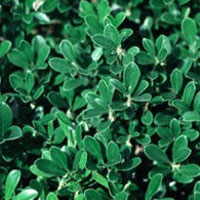Uva Ursi
Uses
Parts Used & Where Grown
The uva ursi plant is found in colder, northern climates. It has red flowers and red berries, which bears like to eat. The leaf is used medicinally.
Our proprietary “Star-Rating” system was developed to help you easily understand the amount of scientific support behind each supplement in relation to a specific health condition. While there is no way to predict whether a vitamin, mineral, or herb will successfully treat or prevent associated health conditions, our unique ratings tell you how well these supplements are understood by the medical community, and whether studies have found them to be effective for other people.
For over a decade, our team has combed through thousands of research articles published in reputable journals. To help you make educated decisions, and to better understand controversial or confusing supplements, our medical experts have digested the science into these three easy-to-follow ratings. We hope this provides you with a helpful resource to make informed decisions towards your health and well-being.
3 Stars Reliable and relatively consistent scientific data showing a substantial health benefit.
2 Stars Contradictory, insufficient, or preliminary studies suggesting a health benefit or minimal health benefit.
1 Star For an herb, supported by traditional use but minimal or no scientific evidence. For a supplement, little scientific support.
This supplement has been used in connection with the following health conditions:
| Used for | Why |
|---|---|
|
1 Star
Urinary Tract Infection
Refer to label instructions
|
Uva ursi may help treat UTIs by killing bacteria in the bladder and urinary tract.
An extract of is used in Europe and in traditional herbal medicine in North America, as a treatment for UTI. This herb is approved in Germany for treatment of bladder infections. The active constituent in uva ursi is arbutin. In the alkaline environment of the urine, arbutin is converted into another chemical, called hydroquinone, which kills bacteria. A generally useful amount of uva ursi tincture is 3–5 ml three times per day. Otherwise, 100–250 mg of arbutin in herbal extract capsules or tablets three times per day can be used. Uva ursi should only be used to treat a UTI under the close supervision of a physician. |
Traditional Use (May Not Be Supported by Scientific Studies)
The leaves and berries were used by numerous indigenous people from northern latitudes. Combined with tobacco, Native Americans sometimes smoked uva ursi. It was also used as a beverage tea in some places in Russia. The berries were considered beneficial as a weight-loss aid. It was found in wide use for infections of all parts of the body because of its astringent, or “drying,” action.
How It Works
How It Works
The glycoside arbutin is the main active constituent in uva ursi and comprises up to 10% of the plant by weight. Hydroquinone derived from arbutin and methylarbutin is a powerful anti-bacterial agent and is thought to be responsible for uva ursi’s ability to treat urinary tract infections. It is believed to be most effective as a urinary tract antiseptic agent if the urine is alkaline.1 No human trials have been published confirming the effectiveness of uva ursi in people with urinary tract infections.
How to Use It
The German Commission E monograph suggests 1/2–3/4 teaspoon (3 grams) of uva ursi steeped in about 5 ounces (150 ml) of boiling water and drunk as an infusion three to four times daily.2 For alcohol-based tinctures, 1 teaspoon (5 ml) three times per day can be used. Standardized extracts in capsules or tablets (containing 20% arbutin), 700–1,000 mg three times per day, can also be taken. Use of uva ursi should be limited to no more than 14 days. To ensure alkaline urine, about 1 1/2 teaspoons (6–8 grams) of sodium bicarbonate (baking soda) mixed in a glass of water can be taken. Baking soda should also not be taken for more than 14 days. People with high blood pressure should not take baking soda. Uva ursi should not be used to treat an infection without first consulting a physician.
Interactions
Interactions with Supplements, Foods, & Other Compounds
Interactions with Medicines
Certain medicines interact with this supplement.
Replenish Depleted Nutrients
-
none
Reduce Side Effects
-
none
Support Medicine
-
none
Reduces Effectiveness
-
none
Potential Negative Interaction
Explanation Required
-
none
Side Effects
Side Effects
Due to the high tannin content in uva ursi, some people may experience cramping, nausea, or vomiting. It is also not recommended for long-term use. Uva ursi should not be taken by pregnant or breast-feeding women and should be used in young children only with the guidance of a healthcare professional.
References
1. Matsuda H, Nakamura S, Tanaka T, Kubo M. Pharmacological studies on leaf of Arctostaphylos uva-ursi (L) Spreng. V. Effect of water extract from Arctostaphylos uva-ursi (L) Spreng (bearberry leaf) on the antiallergic and antiinflammatory activities of dexamethasone ointment. J Pharm Soc Japan 1992;112:673-7.
2. Blumenthal M, Busse WR, Goldberg A, et al. (eds). The Complete Commission E Monographs: Therapeutic Guide to Herbal Medicines. Boston, MA: Integrative Medicine Communications, 1998, 224-5.
Last Review: 03-24-2015

Copyright © 2025 TraceGains, Inc. All rights reserved.
Learn more about TraceGains, the company.
The information presented by TraceGains is for informational purposes only. It is based on scientific studies (human, animal, or in vitro), clinical experience, or traditional usage as cited in each article. The results reported may not necessarily occur in all individuals. For many of the conditions discussed, treatment with prescription or over the counter medication is also available. Consult your doctor, practitioner, and/or pharmacist for any health problem and before using any supplements or before making any changes in prescribed medications. Information expires December 2025.



